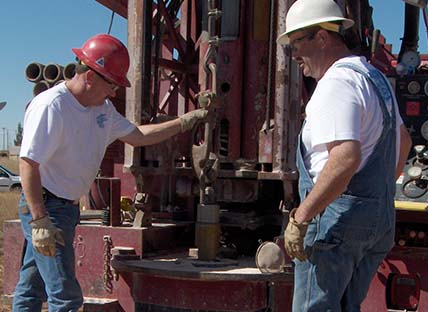Groundwater


Groundwater
Groundwater exists below the earth’s surface in the space between soil and rocks. Groundwater is a source for many drinking water supplies, especially for rural communities. Learn more about groundwater supplies, storage, and recharge.
Resources
Public-Supply Wells See Elevated Levels of Lithium
A USGS study reports that about 45% of U.S. public-supply wells and about 37% of domestic supply wells have concentrations of lithium that could present a potential human-health risk.
In 2021, lithium was added to the EPA’s proposed Unregulated Contaminant Monitoring Rule. The Rule is used by the EPA to collect data for contaminants that are suspected to be present in drinking water and that do not have health-based standards set under the Safe Drinking Water Act.
This is the first national-scale study of lithium occurrence in groundwater; lithium was analyzed in 3,140 samples of untreated groundwater collected from 33 principal aquifers across the U.S. Concentrations of lithium were at levels presenting a potential human-health risk in about 40% of samples of untreated groundwater.
Technical Resources
Reports
Manuals
AWWA Standards
M21 Groundwater
Written to provide a general understanding of groundwater principles and the impact they have on the design, construction, and maintenance of groundwater well systems for water utilities, this manual also covers groundwater protection, planning, evaluation efforts and modeling techniques.
Get the Manual
M63 Aquifer Storage and Recovery
This manual provides a general understanding of the principles of aquifer storage and recovery (ASR).
Get the Manual
ANSI/AWWA A100 Water Wells
This standard describes the minimum requirements for vertical water supply wells and is designed primarily for municipal and industrial applications.
Get the Standard
ANSI/AWWA C654 Disinfection of Wells
This standard describes the procedures for disinfection and bacteriological testing of wells for potable water service following construction, servicing, maintenance, or any other activity or event that might lead to contamination of the water.
Get the Standard
ANSI/AWWA E102 Submersible Vertical Turbine Pumps
This standard describes minimum requirements for submersible vertical turbine pumps utilizing a discharge column pipe assembly, 5 hp or larger, used in water service, including materials, design, manufacture, inspection, and testing.
Get the Standard
ANSI/AWWA E103 Horizontal and Vertical Line-Shaft Pumps
This standard provides minimum requirements for horizontal centrifugal pumps and for vertical line-shaft pumps for installation in wells, water treatment plants, water transmission systems, and water distribution systems.
Get the Standard

Advertisement

AWWA Policy Statements
AWWA’s policy statements are brief statements on protecting and improving water supply, water quality, management, and the interests of the public and the environment. They are written by consensus, subject to review and comment by AWWA committees, councils, and members. Because they represent AWWA’s position on these matters, they are approved by the AWWA Executive Committee of the board of directors.


Technical Committee Engagement
AWWA members are recognized globally for their industry expertise and their generosity in sharing that expertise for a better world through better water. AWWA members participate in committee activities, developing conference programs, writing technical manuals, developing standards, creating educational content and contributing to AWWA publications. Committee members primarily interact through conference calls, emails, and face to face meetings at conferences and events.
Groundwater Resource Committee
Water Resources Planning and Management Committee
Standards Committee on Wells
Membrane Processes Committee
Water Desalting Committee
Advertisement


